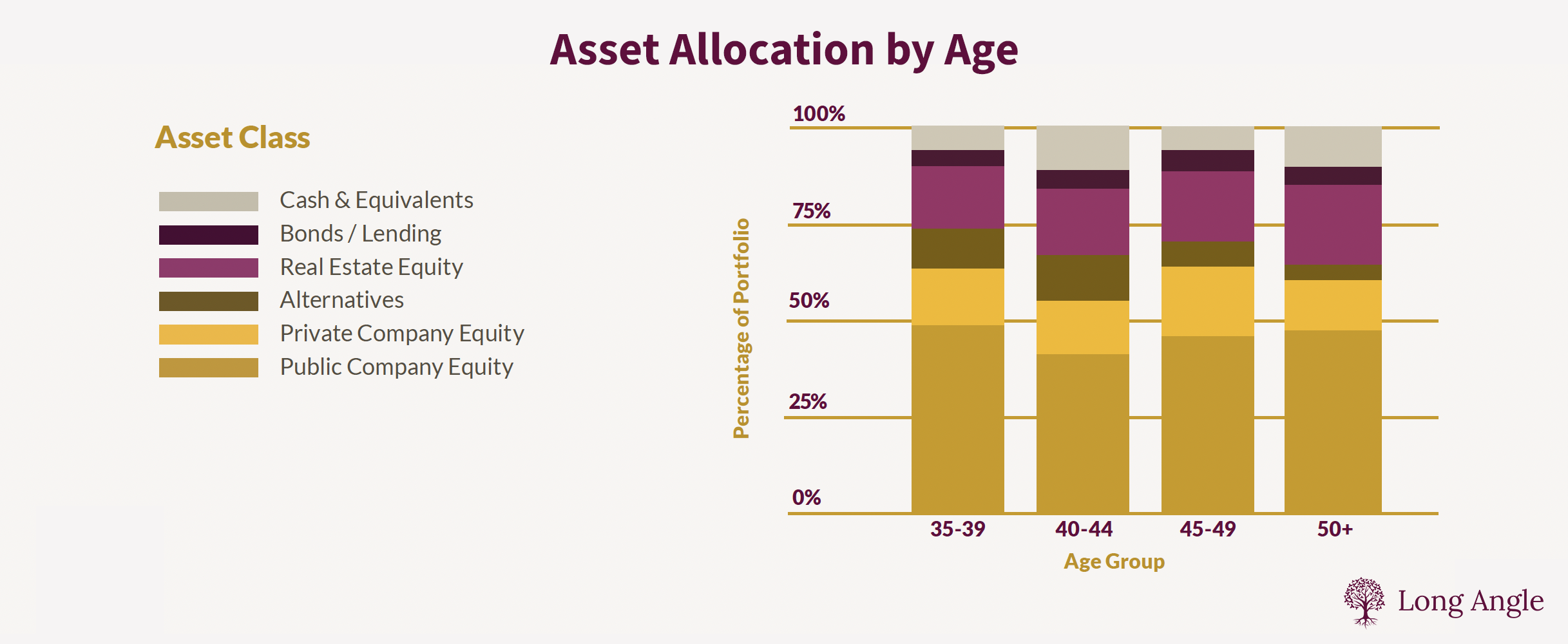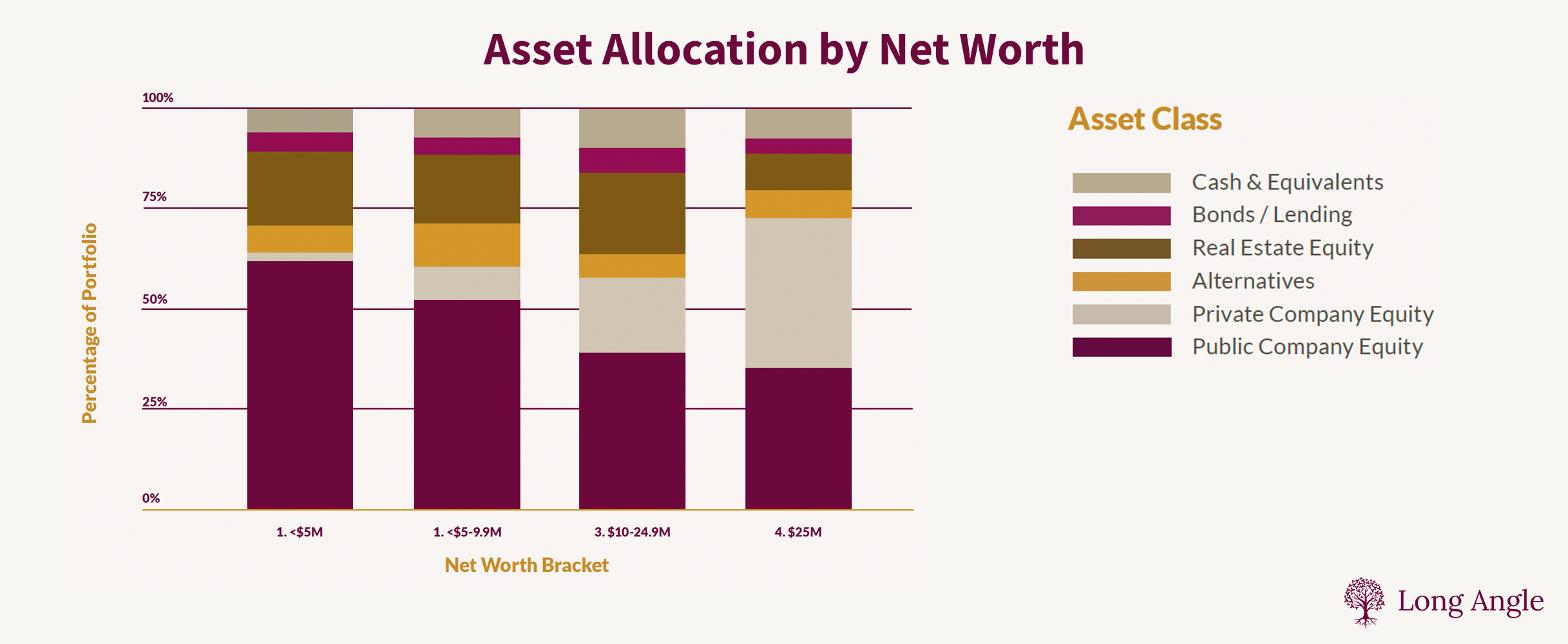2025 High-Net-Worth Asset Allocation Study
Long Angle’s annual High-Net-Worth Asset Allocation Study presents the latest investment trends and strategies, sourced from our community of over 6,000 members—ranging up to ultra-high-net-worth investors.Here
Access the Full Report Here
The 2025 High-Net-Worth Asset Allocation Study, conducted by Long Angle, provides an exclusive look into how high-net-worth individuals allocate their wealth across asset classes. This year’s study highlights shifts in public and private equities, real estate, and alternative investments, reflecting evolving financial strategies in response to market trends and economic conditions.
With insights from high-net-worth investors, this study serves as a benchmarking tool for understanding portfolio composition, risk tolerance, and diversification strategies.
Insights from the 2025 High-Net-Worth Asset Allocation Study
Financial advisors don’t meaningfully change portfolio allocations. Only one-third of respondents work with an RIA, yet their asset allocations are nearly identical to those who self-manage, suggesting that advisors offer value in tax and estate planning but have little impact on investment decisions.
Debt is uncommon among high-net-worth investors. More than one-third of homeowners have no mortgage, and the average debt-to-value ratio is just 30%. Across all assets, total debt remains below 10% of net worth, reflecting a strong preference for low leverage.
Bonds are largely ignored. Even among conservative investors, bonds make up less than 10% of portfolios.
Crypto is a generational divide. While 52% of investors under 35 hold crypto with an average allocation of 9%, older investors have near-zero exposure, signaling a clear shift in risk tolerance and digital asset adoption among younger high-net-worth individuals.
High-net-worth individuals are aggressive savers. Nearly 30% save more than half of their post-tax income, a stark contrast to the 4% U.S. personal savings rate. Almost no respondents are in disaccumulation mode, even those with significant wealth.
Source: Long Angle 2025 High-Net-Worth Asset Allocation Report
What is the current asset allocation for high-net-worth individuals?
In 2025, the average asset allocation includes: 47% in public equities, 15% in private companies, 17% in real estate, 8% in alternatives, 8% in cash and bonds, and 5% in other financial products and lending.
Source: 2025 Long Angle Annual High-Net-Worth Asset Allocation Study
Types of Asset Allocations for High-Net-Worth Investors
High-net-worth individuals allocate their wealth across several key asset classes to balance growth, risk, and liquidity:
Equities – Public equities remain the largest allocation, while private equity ownership grows with net worth.
Fixed Income – Bonds play a minimal role, with investors favoring private credit and direct lending for higher returns.
Real Estate – 81% own a primary residence, and 30% own rental properties, making real estate a preferred asset for income generation and diversification.
Alternative Investments – Crypto, hedge funds, and commodities provide unique diversification benefits. Younger investors lead in crypto adoption, while older investors prefer hedge funds and private credit.
Diversification Strategies for High-Net-Worth Portfolios
The 2025 High-Net-Worth Asset Allocation Study highlights key diversification strategies among high-net-worth investors:
Increased Private Market Exposure – As net worth grows, investors shift allocations to private equity, venture capital, and direct investments.
Real Estate as an Income Hedge – Real estate investments rise among income-focused investors, with many allocating 40%+ to real estate equity.
Minimal Bond Holdings – Fixed-income allocations remain low, with investors favoring private lending and structured credit.
Geographic & Sector Diversification – High-net-worth portfolios are spread across multiple regions and sectors, including technology, healthcare, and renewable energy.
Tactical Asset Allocation – Investors actively rebalance portfolios based on market shifts, interest rate trends, and economic conditions.
Asset Allocation by Age and Net Worth
The 2025 High-Net-Worth Asset Allocation Report study reveals distinct asset allocation trends among high-net-worth individuals based on age and net worth, reflecting their varied risk tolerances and investment goals.
Source: Long Angle 2025 High-Net-Worth Asset Allocation Report
Asset Allocation by Age
Younger Investors (30-39 years) – Higher allocations to private equity and venture capital. Crypto adoption is highest, with an average allocation of 9%.
Middle-Aged Investors (40-59 years) – Balanced exposure to public and private markets, with increasing real estate and fixed-income allocations.
Older Investors (60+ years) – Capital preservation is the priority, leading to higher allocations in bonds, cash, and income-generating real estate investments.
Source: 2025 Long Angle High-Net-Worth Asset Allocation Report
Asset Allocation by Net Worth
Under $5 Million – 62% allocated to public equities, with lower exposure to alternatives and private markets.
$5 Million to $25 Million – Greater allocation to private equity and venture capital. Real estate remains a key investment.
Above $25 Million – 38% of portfolios allocated to private businesses, reflecting increased access to direct investments.
The study highlights a progression from growth-oriented strategies among younger investors to a focus on wealth preservation in older age and higher net worth brackets. This nuanced approach underscores the importance of aligning asset allocation with one's investment horizon, risk tolerance, and financial objectives, serving as a guide for both investors and advisors in optimizing portfolio strategies.
For a detailed breakdown of asset allocation trends, investment strategies, and risk preferences among high-net-worth individuals, download the full 2025 High-Net-Worth Asset Allocation Study by Long Angle.
About Long Angle
Long Angle is a private community of high-net-worth investors who leverage their collective expertise and scale to access and underwrite some of the world's best alternative asset investments. Asset classes range from private equity, search funds, and private credit to secondaries, real estate, and venture capital.
Long Angle is a high-net-worth peer community, not a wealth manager. Members independently make their investment decisions on a deal-by-deal basis. They are treated as partners in every investment, with full transparency regarding the investment team's diligence and underwriting processes. All members receive equal access to negotiated fee discounts.
Membership is free but requires an interview with a current community member, as well as validation of investable assets. Apply Now »
FAQ
-
High-net-worth individuals' asset allocation decisions are influenced by a combination of factors including their risk tolerance, investment goals, time horizon, and the current economic environment. They also consider tax implications, estate planning needs, and liquidity requirements. Strategic asset allocation is tailored to each individual's financial situation and life goals, with adjustments made in response to changes in market conditions, financial objectives, or personal circumstances.
-
High-net-worth individuals should review their asset allocation at least annually or as major life events occur (such as marriage, the birth of a child, or retirement) that could affect their financial goals or risk tolerance. Additionally, significant market fluctuations or economic changes might necessitate more frequent reviews to ensure that the portfolio remains aligned with the individual's investment objectives and risk profile.
-
Alternative investments, such as private equity, hedge funds, real estate, and commodities, play a crucial role in high-net-worth portfolios by providing diversification benefits, potential for higher returns, and reduced overall volatility. These investments can offer unique opportunities not correlated with traditional stock and bond markets, helping to spread risk and enhance returns over the long term. High-net-worth individuals leverage alternative investments also for their potential tax advantages and to gain access to investments that can hedge against inflation or economic downturns.
-
Strategic Diversification: Expanding into alternative investments and real estate, high-net-worth individuals diversify their portfolios to mitigate risk and seek higher returns.
Tactical Adjustments: They adjust allocations based on market conditions and economic forecasts to exploit short-term opportunities without derailing long-term strategies.
Risk Management: Balancing growth and risk through careful investment selection within each asset class is crucial for protecting capital.
Active Review and Rebalancing: Regular portfolio evaluations and adjustments ensure alignment with changing goals and market dynamics.
Professional Advice: High-net-worth individuals rely on financial advisors for complex decision-making, estate planning, and tax strategies, valuing their expertise even as they take a more direct role in managing their investments.
-
The growth of digital assets, including cryptocurrencies and blockchain technologies, has introduced new opportunities for diversification and return on investment for high-net-worth individuals. Despite their volatility, these assets are increasingly included in portfolios for their potential for high returns and as a hedge against inflation and currency devaluation.




